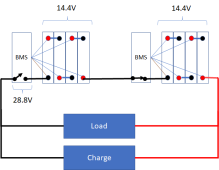Folks,
Trying to understand why there would be any limit to the number of batteries in parallel If each battery had dedicated connections to a properly sized buss bar.
Ampertime's published limits are 4S4P, I understand the series limit as all current flows through all batteries. But the parallel limit isnt quite as obvious. Is this the limit if the batteries are connected in parallel only using battery interconnection? Then the terminals of the battery at the load/charge end of the string will certainly see a lot of current. But if they are all connected to a big buss bar, why would there be a limit?
I would like to put six 200AH ampertimes in parallel. Each battery would have individual cabling (same length) to a set of 1000 amp bus bars.
This exceeds the published 4P limit.
Thanks
ANdy
Trying to understand why there would be any limit to the number of batteries in parallel If each battery had dedicated connections to a properly sized buss bar.
Ampertime's published limits are 4S4P, I understand the series limit as all current flows through all batteries. But the parallel limit isnt quite as obvious. Is this the limit if the batteries are connected in parallel only using battery interconnection? Then the terminals of the battery at the load/charge end of the string will certainly see a lot of current. But if they are all connected to a big buss bar, why would there be a limit?
I would like to put six 200AH ampertimes in parallel. Each battery would have individual cabling (same length) to a set of 1000 amp bus bars.
This exceeds the published 4P limit.
Thanks
ANdy




